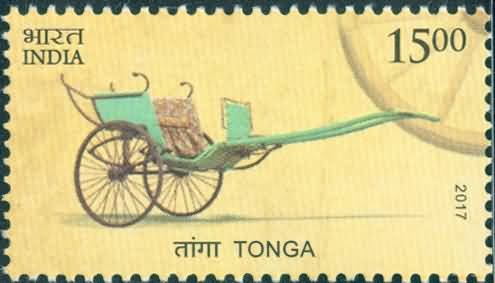Tonga

Technical Data
| Stamp Set | Means of Transport |
|---|---|
| Date of Issue | March 25, 2017 |
| Denomination | Rs. 15 |
| Quantity | 3,000 |
| Perforation | 13 |
| Printer | India Security Press, Nashik |
| Printing Process | Wet Offset |
| Watermark | No Watermark |
| Colors | Multicolor |
| Credit (Designed By) | Sh. Brahm Prakash |
| Catalog Codes |
Michel IN 3133 Yvert et Tellier IN 2824 Stanley Gibbons IN 3287 |
| Themes | Transport |
Introduction
The Tonga, also known as a horse-drawn carriage, is one of the most iconic traditional modes of public transport in India. Simple yet charming, it served as an affordable and accessible means of travel for the common people. For decades, the rhythmic sound of hooves pulling a Tonga was a familiar sight on Indian roads, symbolising a slower, more graceful pace of life.
Origin and Evolution
Introduced widely during the late 19th and early 20th centuries, the Tonga emerged as a popular medium of transportation in both rural and urban India. It bridged the gap between walking and other costlier modes of travel, offering a practical and economical alternative. With time, Tongas became indispensable, especially in small towns and cities, for daily commuting and short-distance travel.
Design and Features
A Tonga is a two-wheeled carriage pulled by a single horse. Its structure is designed for comfort and functionality:
- A wooden or metal frame with seating for 2–6 passengers
- A canopy or open-top roof providing shade and ventilation
- A raised seat for the driver at the front
- Large spoked wheels for smooth movement on uneven roads
The design varies across regions, reflecting local craftsmanship and cultural influences.
Role in Daily Life
For many years, the Tonga served as a primary mode of transport for school children, families, and travellers. It was commonly used for trips to markets, railway stations, town centres, and social gatherings. Tonga owners often shared a close bond with their horses, treating them as companions and essential partners in their livelihood.
Cultural and Social Significance
Tongas are deeply woven into India’s cultural memory. They feature prominently in old Hindi films, literature, and nostalgic accounts of Indian towns. Even today, in many places such as Ayodhya, Mathura, Agra, and parts of Punjab and Rajasthan, Tongas remain a tourist attraction, offering a heritage ride through historic streets. They are also used in festive processions, weddings, and cultural events, retaining their graceful charm.
Legacy and Continuity
Although modern vehicles have gradually replaced Tongas for daily commute, they continue to thrive as symbols of heritage, tradition, and old-world elegance. Their presence reminds us of a time when journeys were unhurried, humane, and connected to nature. The Tonga stands as a living legacy of India’s rural and urban transport history, preserved through passion, culture, and collective memory.
